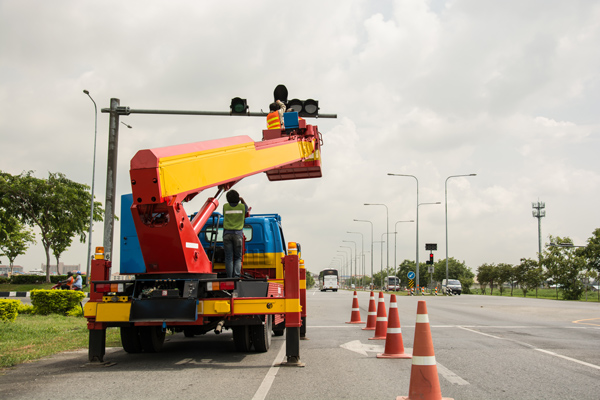Overview
- Off-network data collection lets operations collect data and process transactions regardless of current ERP connectivity status.
- Offline mobility can help solve the challenges associated with remote operations, field mobility or spotty/minimal network access.
- Offline inventory supports data replication onto a mobile device while high availability supports data replication onto an internal server.

Organizations in areas with limited or unreliable network capabilities face unique operational challenges, especially when it comes to tracking inventory and assets in the field.
Without consistent, reliable network access, field service teams are forced to keep track of this information in handwritten notes or local spreadsheets. This data may only be transferred to your ERP database at the end of the day. The process embeds a lag time into each transaction, so it’s difficult to trust inventory levels or to forecast adjustments in the production line.
Facilities with limited network connectivity scenarios share similar technological challenges. Whether it’s a remote oil rig, yard inventory outside your Wi-Fi range, or deep freezer in the food and beverage industry, you don’t want network failures to cause data losses or shut down production.
So how can you collect data in the field, move inventory and communicate with your business systems in situations where connections are dropped, limited or unavailable?
By strengthening their processes with off-network data collection.
What is Off-network Data Collection?
Off-network data collection is a type of offline mobility that lets workers collect data and process transactions regardless of current ERP or network connectivity status.
Without an offline mobility solution, supply chain operations that rely on data collection for activities like processing inventory or queuing up a production order grind to a halt.
Off-network data collection is especially useful for operations that have:
- Remote or offshore locations
- Poor or intermittent network connectivity
- Operational areas without internet connections
- Regularly scheduled ERP maintenance or down time
Off-network data collection combines advanced replication techniques, intelligent queuing and lightly coupled architecture to support reliable 24-hour data collection. Most importantly, this lets organizations transact against the ERP in “close to real time” across the entire enterprise, so you don’t have to second guess if inventory readouts are accurate or worry about lost data during a network outage.
Why Do I Need Off-network Data Collection?
It’s hard to run a business if your workers can’t access the data they need to perform their daily tasks. Or if time-consuming processes, like manual data entry or repeating lost scan data, are creating productivity headaches and hindering operational growth.
On the other hand, it’s also not practical or cost-effective to make every site self-contained or self-sufficient. But you still need to equip teams with the tools to complete tasks, and perform them well, without interruption to your business processes.
That’s where offline mobility solutions come into play.
When Do I Need Off-network Data Collection?
Let’s look at a few scenarios where off-network data collection might be useful:
Out in the Field
Field mobility or field services operations can’t always practically maintain a connection with the network.
A delivery driver might be able to download order information onto their mobile device in the morning but will be out of network range while driving or completing the delivery. However, she still needs to obtain proof of delivery and update inventory levels in the ERP. With off-network data collection, the delivery driver can still use a mobile device to take a picture of a delivery and mark an item as delivered, even if she doesn’t currently have a network connection.
Or, your company may perform regular maintenance in remote field locations. Like this California Utility Company, who was having trouble tracking field inventory on the road. The utility company worker can update field inventory levels as repairs are made. Once network connection is restored, the system will prompt workers to submit the transaction and update the ERP.
No more manual data entry or lost data.
Areas with Limited/Spotty Connections
Sometimes, areas in your warehouse may have unreliable network connections. Or you may be a construction company with acres of yard inventory and overflow storage in areas that just don’t support network access but you still need to be able to capture inventory counts, transfers and more with mobile data collection, just as you do in the more well-connected areas of your warehouse.
Sometimes, the location is just too remote to maintain a reliable connection, as with Trident Seafoods. Trident Seafoods’ Alaskan operations necessitated 24/7 network availability, but the company’s isolated location and inclement Alaskan weather made this challenging.
To solve the problem, the company implemented a high availability offline mobility solution. This let them continue to collect transactions indefinitely during times of lost network connectivity, keeping production running smoothly without any costly delays. When the network regained its connection, the offline transactions cleared and updated in the ERP.
Read the Full Story: How Trident Seafoods Triumphed Over Network Challenges »
Remote Access or Losing Collected Data
Organizations in the food and beverage industry (and others) may also face issues of remote access. An ice cream company, for example, may need to complete inventory counts in a large walk-in freezer where network connections can’t reach, as with Blue Bell Creameries.
The ice cream company also experienced “data drops” in areas like their receiving docks, where the network would drop unexpectedly and lose all the collected data. Instead of resorting back to manual processes or employing timely recounts, Blue Bell enhanced the mobile data collection solution they already used elsewhere in their warehouses with off-network data collection for batch transactions. This let workers store validation data on their mobile device and transact against the ERP once connectivity was restored.
Continue Reading: Blue Bell’s chilling story of lost data »
When to Use Offline Inventory vs High Availability Inventory
There are two main types of off-network data collection: offline inventory and high availability inventory.
Offline Inventory
Offline inventory allows remote or offline operations to secure sets of data by replicating all transactions onto the mobile device. Any new transaction will prompt future updates to your centralized data once connections are restored. This means your on-hand inventory is made up of your actual inventory and your offline inventory.
Offline inventory data collection works well when you’re not processing large volumes of data. Since the data is replicated onto the mobile device itself, data volumes are restricted by the device’s storage capabilities. This is useful if you have areas of spotty connection, like Blue Bell, and need occasional back-ups to minimize lost data and safeguard worker productivity.
High Availability Inventory
High availability replicates all transactions to an internal server, so it’s better equipped at handling large volumes of data. This makes the most sense for remote facilities, like Trident Seafoods.
When high availability data collection is enabled, workers can validate against existing data and create new transactions with the use of a replicated snapshot. Once the network connection is re-established, the remote transactions are queued from the remote, internal server to the central server. This prompts the central server to process the offline transactions, updating the data and replicating back to the remote location.
Safeguarding Operational Data in Any Scenario
Off-network data collection technology has the power to transform even the most distinct operational challenges. From field mobility, unreliable network connections and remote locations, to areas with no network connections at all, you can capitalize on the powerful benefits of mobile data collection solutions while safe-proofing critical operations from disruption.








